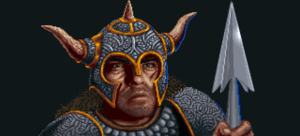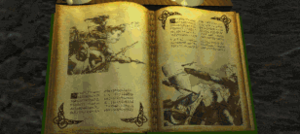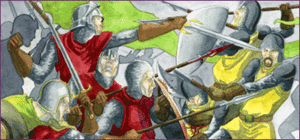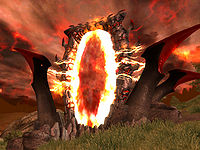Lore:Third Era Wars
The following is a list of all known wars and conflicts during the Third Era.
Contents
The War of the Isle[edit]
The War of the Isle was a conflict in the early-mid Third Era in which King Orgnum of the island-kingdom, Pyandonea attacked the Summerset Isles in their closest attempt to claim the province. The war took place in 3E 110, twelve years into Emperor Antiochus Septim's reign and later involved both the Third Empire and the Psijic Order of Artaeum.
The War of the Red Diamond[edit]
Kintyra II became Empress on the death of her father, Antiochus, in 3E 120. Her uncles, Cephorus King of Gilane and Magnus King of Lilmoth, attended the coronation, but her aunt, Queen Potema of Solitude, was banished after insulting Kintyra in front of the Elder Council. Potema was scheming to obtain the throne for herself and her son, Uriel. Her schemes resulted in a civil war known as the War of the Red Diamond, the name coming from the symbol of the Imperial family. In early surprise attacks, Skyrim and High Rock were easily defeated by the force of Queen Potema. The war was highly contested, but was abruptly decided by the death of Potema's claimant, Uriel III, in 3E 127. While the end of the succession crisis ostensibly brought an end to the conflict, Potema held out in Solitude with an undead army for another decade.
During this civil war, the Knights of the Nine were fractured and later completely dissolved. The four recovered relics of Pelinal Whitestrake were used in the war and lost afterwards.
More information can be found in the books The Wolf Queen and Biography of the Wolf Queen.
Major Battles[edit]
- Battle of Ichidag, 3E 127. Forces under Cephorus defeated Uriel III, who was killed in the aftermath of the battle. Cephorus was crowned Emperor.[3][5]
- Battle of Falconstar, 3E 127. Contemporaneously with the Battle of Ichidag, the forces of Queen Potema fought the forces of Magnus Septim in Skyrim. Upon learning of her son's capture, Potema flew into a rage and led a successful assault on Magnus' weakest flank, causing Magnus and his army to retreat. Word reached them soon after of Uriel III's death.
- Siege of Solitude, 3E 137. The Wolf Queen, Potema of Solitude, was finally defeated after a month-long siege of her castle. Although not a full part of the War of the Red Diamond, the siege is best viewed as a postscript, as with the death of the entire royal family except Cephorus, Magnus, Pelagius and Jolethe, all possible argument over the line of succession was ended.[4]
The Camoran Usurper's Invasion[edit]
Haymon Camoran, known as the Camoran Usurper, a pretender to the Camoran throne of Valenwood, conquered all of Valenwood and Hammerfell alongside a portion of western Cyrodiil with an army of daedra and undead. However it's believed that whichever dark power he had aligned himself with had abandoned him towards the end of the war, as he had to fall back on traditional armies of Redguards and Bosmer, alongside conventional trickery as he made his way to northern Hammerfell, and attempted to invade High Rock. Camoran had aligned with Eight Lords of High Rock (referred to as the Eight Traitors), who sympathized more with the Usurper as an opponent to the Empire.
Emperor Cephorus II was a Nord and more sympathetic to Skyrim and Morrowind than High Rock as previous emperors had been, as well as being embroiled in a succession dispute at the time. The Emperor would attempt to send mercenaries to halt Camoran, but they switched sides as Camoran had bribed them. Overall the image and reputation of the Empire had been greatly damaged in the western provinces during the War.
The various lords of High-Rock were unable to coordinate thanks to their internal politics, however Baron Othrok of Dwynnen and his allies managed to halt Camoran's armies at Dwynnen. Then in 3E 267, the combined armies of High Rock mustered the greatest navy ever seen, and defeated and killed the Camoran Usurper and his armies on the Iliac Bay and on land.
Major Battles[edit]
- Battle of Dragontooth, 3E 253. The defeat of the armies of Taneth and Rihad lead to the fall of southern Hammerfell.[6]
- Battle of Wightmoor, 3E 253. The Nightmare Host had taken over Dwynnen, but they were later defeated by Othrok and his armies from the forest. He later became the first Baron of Dwynnen and started to prepare his fight against the Usurper.[7][8]
- Battle of Firewaves, 3E 267. The combined armies of Dwynnen, Ykalon, Phrygia, and Kambria led by Dwynnen's Baron Othrok finally defeated the Usurper.[8]
The Invasion of Akavir[edit]
23rd of Rain's Hand, 3E 288 - 3E 290[9]
Uriel Septim V attempted to invade the continent of Akavir, starting with the Tsaesci Kingdom. The preparations for the invasion begun in the 3E 268,[10] almost immediately after Uriel V took the throne, started off with the invasion of several islands between Tamriel and Akavir and were concluded in 3E 286 when final scouting actions were done on Akavir soil.
Uriel V first started by conquering several islands between 3E 271-284, including Roscrea, Cathnoquey, Yneslea, and Esroniet to act as supply routes to Akavir. While the invasion of Akavir ended in failure, these acquisitions would stay with the Third Empire.
A special Far East Fleet, the most powerful fleet in Tamriel's history, was created for the invasion. After that, the Expeditionary Force was sent to Akavir in 3E 288. Imperial forces landed near the mouth of a river and found no opposition, taking an abandoned village and renaming it Septimia. Despite initial success, due to unusual weather, no permanent supply routes were possible to establish. The Emperor personally oversaw the war effort and colonization, making the decision to bring in colonists rather than reinforcements since the Akavir army was nowhere to be seen. The Empire advanced further inland, still finding no signs of the Akavir, who were seemingly attempting to draw the Tamriel forces in. Early in the winter of 3E 290, the Akaviri advanced, attempting to surround the Imperial forces. While the Legions acquitted themselves well, they were forced to fight on the defensive. The Emperor attempted a retreat and ultimately ordered the complete withdrawal from Akavir. However, the majority of Uriel V's invasion force, including thousands of colonists, were killed and the emperor himself was slain in combat, ending the conflict.
Major Battles[edit]
- The Far East Fleet, 3E 271 - 3E 284. The Far East Fleet sets sail for Akavir on the way conquering the kingdoms of Cathnoquey, Esroniet, Roscrea, and Yneslea.
- Taking of Septimia, Mid Year 3E 288. Six weeks after Uriel's fleet took off from Black Harbor on Esroniet, they landed on Akavir and took a river port town from the Tsaesci populace that abandoned it as soon as they saw the Expeditionary Force. They renamed it Septimia and it was to be the first colony of the newly founded Imperial Province of Akavir.
- Taking of Ionith, 3E 288. Soon after capturing Septimia, the emperor himself marched along the river and found another abandoned city, named Ionith after it was taken.
- Battle in the northern mountains, Sun's Height 3E 289. The emperor had his legions attack the amassing Tsaesci forces north of Ionith. Even though the Tsaesci were caught off guard and their leader captured, the legions were forced to fall back and took heavy losses during the retreat. As a result, Ionith was besieged and remained such until its eventual fall.
- Battle of Ionith, 3E 290. After contact was established with the Far East Fleet, that was sent to return with supplies, the emperor ordered the army to break through the enemy lines and to fall back to Septimia. Not far from Ionith, on the road to Septimia, the remains of the Expeditionary Force were ambushed. Uriel V and his personal guard, the Tenth Legion, stayed behind to hold off the Tsaesci, while the others continued their retreat. Only two men from the Tenth Legion survived to tell the tale of emperor's demise.
- Battle of Septimia, 3E 290. Two days after Ionith was abandoned, the fleet that had returned with the supplies found the town of Septimia under heavy siege by Tsaesci forces. They drove the attackers away, rescued the survivors and left for Tamriel.
Military intimidations of Uriel VII[edit]
Around this time, it is said that Emperor Uriel Septim VII planned to "gather the whole of Nirn under the imperial flag."[12] Circa 3E 376, Uriel allied himself with Jagar Tharn, appointing him to the station of Imperial Battlemage of the Empire.[13][12] Uriel greatly benefited from arcane support and "shrewd" council of his close advisor in the conflicts to come. It is written that these decades were "marked by aggressive expansion and consolidation of Imperial influence throughout the empire, but especially in the East, in Morrowind and Black Marsh, where the Empire's power was limited, Imperial culture was weak, and native customs and traditions were strong and staunchly opposed to assimilation."[11] Uriel soon outstripped the masterful Jagar Tharn in the skills of threat and diplomacy, co-opting the House Hlaalu of Morrowind as an advance guard for Imperial interests.[11] Uriel's expansionism was described as an "aggressive campaign of military intimidation and diplomatic accommodation".[11]
Major Battles[edit]
- Battle of Borim Valley: Sometime between 3E 371 and 3E 389),[nb 0] General Talin Warhaft of the Septim Empire's Imperial Guard fought a rival force in the Borim Valley.[14] Warhaft's men had routed the enemy and would have captured them all if not for the brave sacrifice of a Sergeant on the opposing side, who had held the pass long enough for his men to retreat to safety at the cost of his own life.[14]
Imperial Simulacrum[edit]
Introduction[edit]
Imperial Battlemage Jagar Tharn betrayed and secretly imprisoned Emperor Uriel Septim VII and used Illusion magic to masquerade as the Emperor for a decade.[11] Imperial authority declined under the Simulacrum, resulting in a series of provincial wars.
The Five Year War[edit]
The Five Year War was a war that took place between the Bosmer of Valenwood and the Khajiit of Elsweyr. The Bosmer claim that the war began in 3E 394 when Khajiit bandits started attacking wood caravans headed for Valenwood. The Khajiit claim that the war began in 3E 395 when the Bosmer attacked the city of Torval in retaliation for the bandit attacks. This border dispute soon turned into a bloody war that lasted for 4 years and 9 months. Thus it was named the Five Year War. Eventually, Elsweyr defeated Valenwood and expanded its territory slightly west, taking both banks of the Xylo River.
The Arnesian War[edit]
What started as a simple slave revolt in the House Dres lands to the south escalated into a full war between Morrowind and Black Marsh.[15] The cause of the war was the death of a Dunmer trader named Roris, who was later canonized into a saint by the Tribunal Temple.[16] He was captured by the Argonian rebels and when he refused to denounce his faith, he was brutally tortured and murdered. When news of his death reached the rest of Morrowind, war was declared on Black Marsh. Morrowind's armies ultimately defeated the Argonians and expanded Morrowind's territory to the south.[17]
The father of the famous Dunmer painter Rythe Lythandas was a known participant in the war. After peace was established, a commission was created to repair the damage done by the war.[18]
War of the Blue Divide[edit]
Named after the body of water separating them, the War of the Blue Divide pitted Summerset Isle against its former ally Valenwood. After a vicious but short war, Summerset defeated Valenwood,[19] gaining several coastal islands as a result of the war.[18] The most notable damage from the war was when the Altmeri destroyed many of Valenwood's harbors.[20] The war occurred soon after Valenwood’s war with Elsweyr, meaning Valenwood was in an already weakened state. The war took an even worse turn, however, when the Khajiit took advantage of Valenwood's further distress, reigniting the war and forcing the Wood Elves to fight on two fronts.
The only known episodes concerning the war were when, in 3E 396, the Bosmeri Parikh tribe began their rampage through southeastern Valenwood against other tribes, receiving aid from Summerset itself.[21] It is unknown whether or not this was the cause of the war.
Major Battles[edit]
- Siege of Woodhearth, 3E 397. Summerset Isle surrounded the coastal city with the intent of starving its inhabitants and forcing them to surrender. Since the Bosmer practice cannibalism, the attack was presumed a tactical error on Summerset's part. A humorous contemporary remark stated that "at the end, only one fat wood elf will remain to wave the flag".[22]
The War of the Bend'r-mahk[edit]
The War of the Bend'r-mahk was a conflict that started in 3E 397 during the Imperial Simulacrum period between the provinces of Hammerfell, Skyrim and High Rock.
During the war Skyrim defeated the forces of Hammerfell and High Rock and claimed many miles of the eastern parts of those provinces, including the cities of Elinhir and Jehanna. Some of these territories were claimed to have been lost in previous wars at the expense of Skyrim. The Redguards harbored a fierce grudge against Skyrim, and yearned for a chance to take back land that was seized from them.
Behind the scenes, the conflict was being used by Jagar Tharn and Pergan Asuul to create a Shadow of Conflict, or Umbra' Keth. However, the villains' plans were put to an end by the Soul of Conflict, a commoner from Azra's Crossing that was roped into the shadow wars of higher players through a series of events.
After peace was established, a commission was created to repair the damage done by the war.
Invasion of the Battlespire[edit]
The Daedric legions of Mehrunes Dagon invaded the Imperial Battlespire, slaughtering the stationed Imperial Battlemages and blocking reinforcements from Nirn. However, an apprentice of the Imperial Battle College arrived at the facility and put an end to Dagon's machinations by banishing the Daedric Prince to the Wells of Oblivion, an action which subsequently caused the shattering of Battlespire into ruin.[23][24]
Despite the recommendations of the Imperial Treasury, Battlespire was later recaptured by the Empire.[25][26] And while the Weir Gate still stood, the rest of the proving ground remained destroyed, along with ability to access the Oblivion realms using the Voidgate.[24]
Conclusion[edit]
The Imperial Simulacrum was ended when the Eternal Champion defeated Jagar Tharn in the Imperial Palace labyrinths, while also restoring the rightful Emperor to the throne, ushering in the following period called the Restoration.[27][28]
Fractious warring and revolt[edit]

Circa 3E 399[29][nb 4] - Circa 3E 417[30][nb 2]
Despite the Restoration of the rightful Emperor and the ending of the Imperial Simulacrum, for too long the previous "unworthy heirs" of the Septim Dynasty allowed the political bonds of the Empire to weaken and crack, finally resulting in "the provinces of Tamriel fighting among themselves like neglected children, drunk with rebellion".[29]
The major events of this period[nb 1] are rather uncertain outside of the Wars of the Iliac Bays and a conflict between Dark Elves and Nords.[29][31][nb 3] In a biography of Emperor Uriel Septim VII, it is written that at this time the Emperor had "turned from the aggressive campaign of military intimidation and diplomatic accommodation of his earlier years, and relied instead on clandestine manipulation of affairs behind the scenes, primarily through the agencies of the various branches of the Blades";[11] the Order of Blades of this time were also known to organize formal assaults if need be.[32] The Imperials' formal colonization of Vvardenfell circa 3E 414, in collaboration with the King of Morrowind, was also a very notable event during this time.[11]
Seemingly, the warring was put to end in 3E 417, when the Miracle of Peace occurred.[30][nb 2]
The War of Betony[edit]
The War of Betony (known as the Siege of Betony to Sentinel)[33] was caused when Lord Mogref of Betony asked King Lysandus of Daggerfall for protection against pirates and other brigands. King Camaron of Sentinel and his advisors, citing an old contract that suggested Betony was a holding of their kingdom, declared war. Hostilities ended after Lysandus' son, Gothryd, who became king after his father was killed in battle at Cryngaine Field, won the battle and defeated Camaron in single combat. Sentinel surrendered and Betony passed under the control of Daggerfall.
More information can be found in two books, both called The War of Betony. Vulper Newgate's version contains the official history, as written by the victors; Fav'te's book, however, tells the story from the viewpoint of a citizen of Sentinel. The Daggerfall Chronicles also provides a slightly different version of the story, a summary of which can be read here.
Major Battles[edit]
- Battle of the Bluffs: The first major battle of the war. Won by Daggerfall.[34]
- Siege of Craghold: The Island of Craghold was besieged by the forces of Sentinel for several days, but the siege was broken by Daggerfall forces under Lord Bridwell.[34][35]
- Battle of Cryngaine Field: Final battle of the conflict. The battlefield was covered in a dense mist created by Skakmat, and after it lifted King Lysandus was found to have perished from an arrow through either his heart[6] or his throat.[34][33] His son Gothryd was crowned on the battlefield and led the army to victory.
Oblivion Crisis[edit]
The Oblivion Crisis, also known as the Great Anguish, was a total war between the Daedra and the population of Tamriel. It began with the assassination of Uriel Septim VII and all of his known heirs in 3E 433. Shortly afterward, Oblivion Gates to the Deadlands opened across Tamriel and Daedra poured out as the result of a fanatical cult of worshippers of Mehrunes Dagon known as the Mythic Dawn. Widespread devastation and casualties resulted across entire provinces. The Daedra besieged Skyrim, and laid waste to the Old Holds. In Black Marsh, the Hist called back many Argonians to fight off the Daedra. According to An-Xileel the Daedra were forced to close their Oblivion gates in Black Marsh due to Argonian counter invasion. In Cyrodiil, the city of Kvatch was entirely destroyed.
Notes[edit]
References[edit]
- ^ Pocket Guide to the Empire, 3rd Edition: The Blessed Isle: Alinor and the Summersets — Imperial Geographical Society, 3E 432
- ^ The Wolf Queen, v4 — Waughin Jarth
- ^ a b Brief History of the Empire v 2 — Stronach k'Thojj III
- ^ a b The Wolf Queen, v8 — Waughin Jarth
- ^ The Madness of Pelagius — Tsathenes
- ^ a b c The Daggerfall Chronicles — Ronald Wartow
- ^ a b The Third Era Timeline — Jaspus Ignateous
- ^ a b The Fall of the Usurper — Palaux Illthre
- ^ Report: Disaster at Ionith — Lord Pottreid, Chairman
- ^ Brief History of the Empire v 3 — Stronach k'Thojj III
- ^ a b c d e f g h A Life of Uriel Septim VII — Rufus Hayn
- ^ a b GOG In-Client Game Overview, The Elder Scrolls: Arena
- ^ The Real Barenziah — Anonymous
- ^ a b Arena character creation scenarios
- ^ Pocket Guide to the Empire, 3rd Edition: The Temple: Morrowind — Imperial Geographical Society, 3E 432
- ^ Lives of the Saints — Tribunal Temple
- ^ Pocket Guide to the Empire, 3rd Edition: The War with the Trees: Argonia and the Black Marsh — Imperial Geographical Society, 3E 432
- ^ a b c A Dance in Fire, Chapter 7 — Waughin Jarth
- ^ a b Pocket Guide to the Empire, 3rd Edition: All the Eras of Man, A Comprehensive History of our History — Imperial Geographical Society, 3E 432
- ^ A Dance in Fire, Chapter 6 — Waughin Jarth
- ^ Words and Philosophy
- ^ A Dance in Fire, Chapter 5 — Waughin Jarth
- ^ Events of Battlespire
- ^ a b The Doors of Oblivion — Seif-ij Hidja
- ^ Battlespire Athenaeum
- ^ Tamrielic Lore — Yagrum Bagarn
- ^ Events of Arena
- ^ Biography of Queen Barenziah — Stern Gamboge, Imperial Scribe
- ^ a b c d e Daggerfall Introduction
- ^ a b The Warp in the West — Ulvius Tero
- ^ Assassination!
- ^ Lady Brisienna's dialogue during the Totem, Totem, Who Gets the Totem? in Daggerfall
- ^ a b The War of Betony — Fav'te
- ^ a b c The War of Betony — Vulper Newgate, 3E 404
- ^ Jokes — Butha Sunhous
- ^ French version of Arena's Manual Intro Story
- ^ War Tax dialogue during Morrowind
- ^ Daggerfall User's Guide
- ^ PC Review Magazine: September 1995
- ^ The Elder Scrolls Codex
- ^ Shadowkey cutscenes
- ^ The Elder Scrolls V: Skyrim - The Skyrim Library, Vol. 1: The Histories
Note: The following references are considered to be unofficial sources. They are included to round off this article and may not be authoritative or conclusive.
|
|||||||||||||||||



